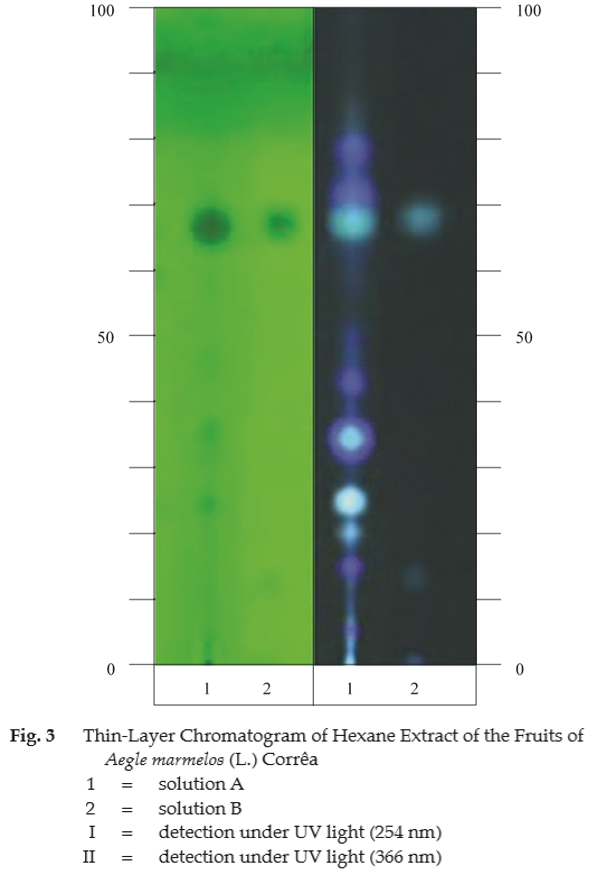ตำรามาตรฐานยาสมุนไพรไทย
Thai Herbal Pharmacopoeia
สำนักยาและวัตถุเสพติด กรมวิทยาศาสตร์การแพทย์ กระทรวงสาธารณสุข
Bureau of Drug and Narcotic, Department of Medical Sciences, Ministry of Public Health(Tinospora crispa (L.) Hook.f. & Thomson)
(Nelumbo nucifera Gaertn.)
(Centella asiatica (L.) Urb.)
(Centella Dry Extract)
(Centella Cream)
(Mesua ferrea L.)
(Piper sarmentosum Roxb.)
(Piper sarmentosum Roxb.)
(Pterocarpus santalinus L. f.)
(Santalum album L.)
(Senna tora (L.) Roxb.)
(Senna alata (L.) Roxb.)
(Senna Alata Tea)
(Piper retrofractum Vahl)
(Myristica fragrans Houtt)
(Andrographis paniculata (Burm. f.) Nees)
(Andrographis Capsules)
(Allium ascalonicum L.)
(Ocimum tenuiflorum L.)
(Curcuma longa L.)
(Turmeric Capsules)
(Turmeric Dry Extract)
(Turmeric Dry Extract Capsules)
(Arcangelisia flava (L.) Merr.)
(Curcuma sp.)
Harrisonia perforata (Blanco) Merr.
(Aristolochia pierrei Lecomte)
(Zingiber officinale Roscoe)
(Ginger Capsules)
(Ginger Tea)
(Cassia fistula L.)
(Nardostachys jatamansi (D. Don) DC.)
(Angelica sinensis (Oliv.) Diels)
Artemisia annua L.
(Ligusticum sinense Oliv. cv. Chuanxiong)
(Neopicrorhiza scrophulariiflora Pennell)
(Atractylodes lancea (Thunb.) DC.)
(Aucklandia lappa Decne)
(Terminalia chebula Retz.)
(Angelica dahurica (Hoffm.) Benth. & Hook. f. ex Franch. & Sav. var. dahurica)
(Kaempferia parviflora Wall. ex Baker)
(Hibiscus sabdariffa L.)
(Roselle Tea)
(Allium sativum L.)
(Zingiber zerumbet (L.) Sm.)
(Wurfbainia testacea (Ridl.) Škorničk.& A. D. Poulsen)
(Cannabis sativa L.)
(Myristica fragrans Houtt)
(Dracaena cochinchinensis (Lour.) S. C. Chen)
(Ficus racemosa L.)
(Hyptis suaveolens (L.) Poit.)
Clerodendrum indicum (L.) Kuntze
(Phyllanthus emblica L.)
(Citrus hystrix DC.)
(Citrus hystrix DC.)
(Areca catechu L.)
(Momordica charantia L.)
Moringa oleifera Lam.
(Aegle marmelos (L.) Corrêa)
(Solanum trilobatum L.)
(Morus alba L.)
Gynostemma pentaphyllum(Thunb.)
Makino
(Clinacanthus nutans (Burm. f.) Lindau)
(Cissus quadrangularis L.)
(Mimusops elengi L.)
(Zingiber montanum (J. König) Link. ex A. Dietr.)
(Piper betle L.)
(Capsicum annuum L.)
(Capsicum Oleoresin)
(Capsicum Gel)
(Piper nigrum L.)
(Piper nigrum L.)
(Eurycoma longifolia Jack)
(Thunbergia laurifolia Lindl.)
(Piper wallichii (Miq.) Hand.-Mazz.)
Senna garrettiana (Craib) H. S. Irwin & Barneby
(Terminalia bellirica (Gaertn.) Roxb.)
(Terminalia chebula Retz.)
(Caesalpinia bonduc (L.) H. Roxb.)
(Tarlmounia elliptica (DC.) H. Rob., S. C. Keeley, Skvaria & R. Chan)
(Hog Creeper Vine Dry Extract Capsiles)
(Hog Creeper Vine Dry Extract)
(Brachypterum scandens (Roxb.) Miq.)
(Lepidium sativum L.)
(Nigella sativa L.)
(Cuminum cyminum L.)
(Foeniculum vulgare Mill.)
(Plantago ovata Forssk.)
(Pimpinella anisum L.)
(Carum carvi L.)
(Anethum graveolens L.)
(Trachyspermum ammi (L.) Sprague)
Albizia procera (Roxb.) Benth.
(Acorus calamus L.)
(Tiliacora triandra (Colebr.) Diels)
Cyanthillium cinereum (L.) H. Rob.
(Orthosiphon aristatus (Blume) Miq.)
Murdannia loriformis (Hassk.) R. S. Rao & Kammathy
(Capparis micracantha DC.)
(Chrysopogon zizanioides (L.) Roberty)
(Cyperus rotundus L.)
(Cannabis sativa L.)
(Syzygium aromaticum (L.) Merr. & L. M. Perry)
(Boesenbergia rotunda (L.) Mansf.)
(Acanthus ebracteatus Vahl)
(Acanthus ilicifolius L.)
(Kaempferia galanga L.)
(Curcuma comosa Roxb.)
Betula alnoides Buch.-Ham. ex D. Don
Cannabis sativa L.
Carthamus tinctorius L
Mitragyna speciosa (Korth.) Havil
Mallotus repandus (Rottler) Müll. Arg
Azadirachta indica A. Juss. var. siamensis Valeton
Azadirachta indica A. Juss. var. siamensis Valeton
Punica granatum L.
Rhinacanthus nasutus (L.) Kurz
Baliospermum solanifolium (Burm.) Suresh
Curcuma aeruginosa Roxb
Boesenbergia kingii Mood & L. M. Prince
Senegalia rugata (Lam.) Britton & Rose
Acacia concinna (Willd.) DC.
Senegalia rugata (Lam.) Britton & Rose
Acacia concinna (Willd.) DC.
Senna alexandriana Mill. var. alexandriana
Cassia acutifolia Delile, Cassia angustifolia Vahl
Butea superba Roxb. ex Willd.
[Plaso superba (Roxb. ex Willd.) Kuntze, Rudolphia superba (Roxb. ex Willd.) Poir.
Pueraria candollei Graham
ex Benth. var. mirifica (Airy Shaw & Suvat.) Niyomdham
Streblus asper Lour.
Suregada multiflora (A. Juss.) Baill. (Gelonium
multiflorum A. Juss.
Bael Fruit is the dried mature fruit of Aegle marmelos (L.) Corrêa [Belou marmelos (L.) A. Lyons, Crateva marmelos L., Feronia pellucida Roth] (Family Rutaceae), Herbarium Specimen Number: DMSC 5187, Crude Drug Number: DMSc 1137.
Constituents Bael Fruit contains coumarins (e.g., imperatorin or marmelosin, psoralen). It also contains alkaloids, flavonoids, tannins, volatile compounds, gum, etc.
Description of the plant (Figs. 1a, 1b) Tree 6 to 12 m tall; stem and branch spiny; spine(s) single or paired, subulate, 1 to 4 cm long. Leaves digitately trifoliolate, alternate, petiolate; petiole 2 to 4 cm long, slightly swollen at base; leaflet elliptic, ovate or ovate-lanceolate, terminal one 5 to 16 cm long, 2 to 10 cm wide, lateral ones subsessile, up to 7 cm long, up to 4 cm wide, apex acute to acuminate, base obtuse to cuneate, margin crenulate, glabrous, pellucid-dotted. Inflorescence racemose or cymose, some branched, axillary or terminal, 3 to 6 cm long; peduncle minutely puberulent. Flower fragrant, greenish white, 2 to 3 cm wide; pedicel 0.4 to 1.5 cm long, pubescent; calyx 4- or 5-lobed, lobe deltoid-ovate or lanceolate, 1.5 to 3 mm long, pubescent, caducous; petals 4 or 5, thick, externally greenish, internally greenish white, oblong-obovate, about 1.4 cm long, about 8 mm wide; stamens 35 to 50, white, filament subulate, 4 to 7 mm long, anther narrow lanceolate with sagittate base, hairy; ovary superior, urn-shaped, light green, glabrous, 8- to 22-loculed, each with 5 or more ovules, style short, stigma capitate. Fruit globose or slightly pear-shaped, 5 to 12 cm wide, greenish turning yellowish brown when ripe, glabrous, rind hard, about 3 mm thick, inside with 8 to 22 segments; pulp orange, slimy, aromatic. Seeds 6 to 10 in each segment, brown, oblong, flat, about 1 cm long, densely clothed with thick fibrous hairs, embedded in transparent sticky gum.
Description Odour, aromatic, characteristic; taste, sweet and sour, astringent.
Macroscopical (Figs. 1a) Transverse slices of fruit, round or ovate, curved, 3 to 10 cm wide, 0.5 to 1 cm thick; rind greyish brown to brownish, smooth, hard; pulp shrunken, brownish orange or reddish brown, with radially arranged elliptic cavities, some containing seeds and viscous substance.
Microscopical (Figs. 2a, 2b) Transverse section of the fruit shows epicarp, mesocarp and endocarp. Epicarp, cuticle layer, a thick-walled epidermal layer, a region of thick-walled parenchyma, some of which containing prismatic crystals or dark brown to brownish substance, large lysigenous oil cavities, and scattering sclereids. Mesocarp, region of thick-walled sclereids, numerous ribbon or sectional view of vascular bundles, thick- and thin-walled parenchyma, some of which containing starch grains. Endocarp, layers of thin-walled parenchyma cells, some of which containing starch grains, layers of thick-walled sclereids and scattering oil droplets surrounding seed cavities.
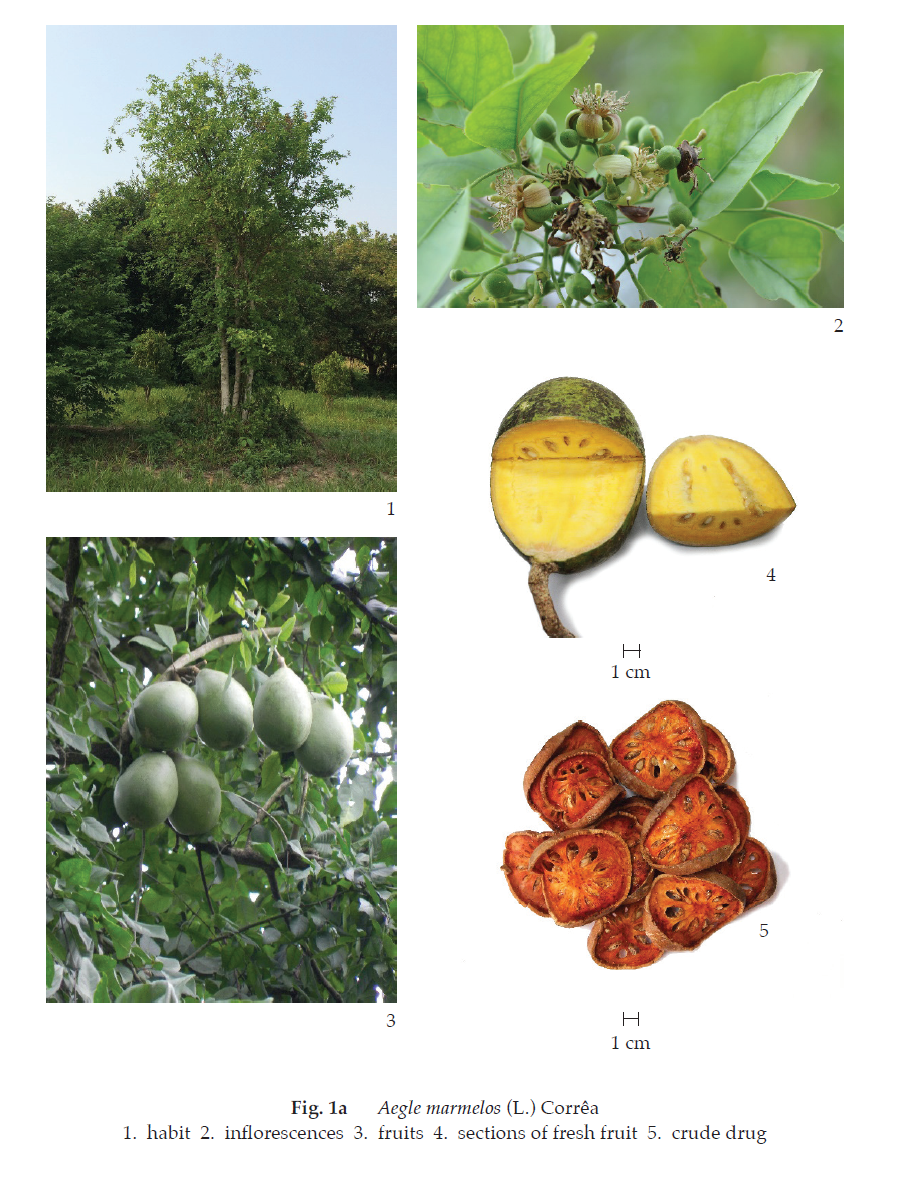
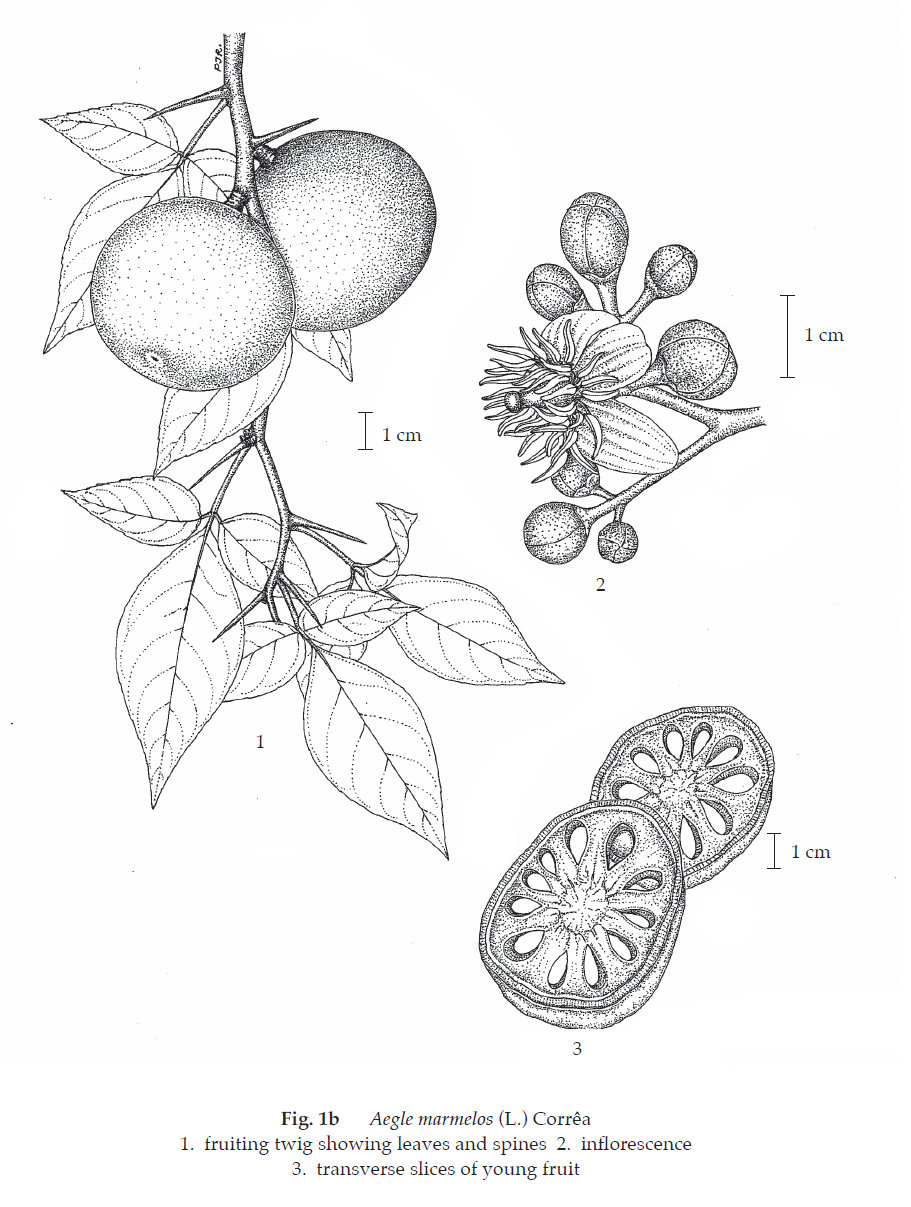
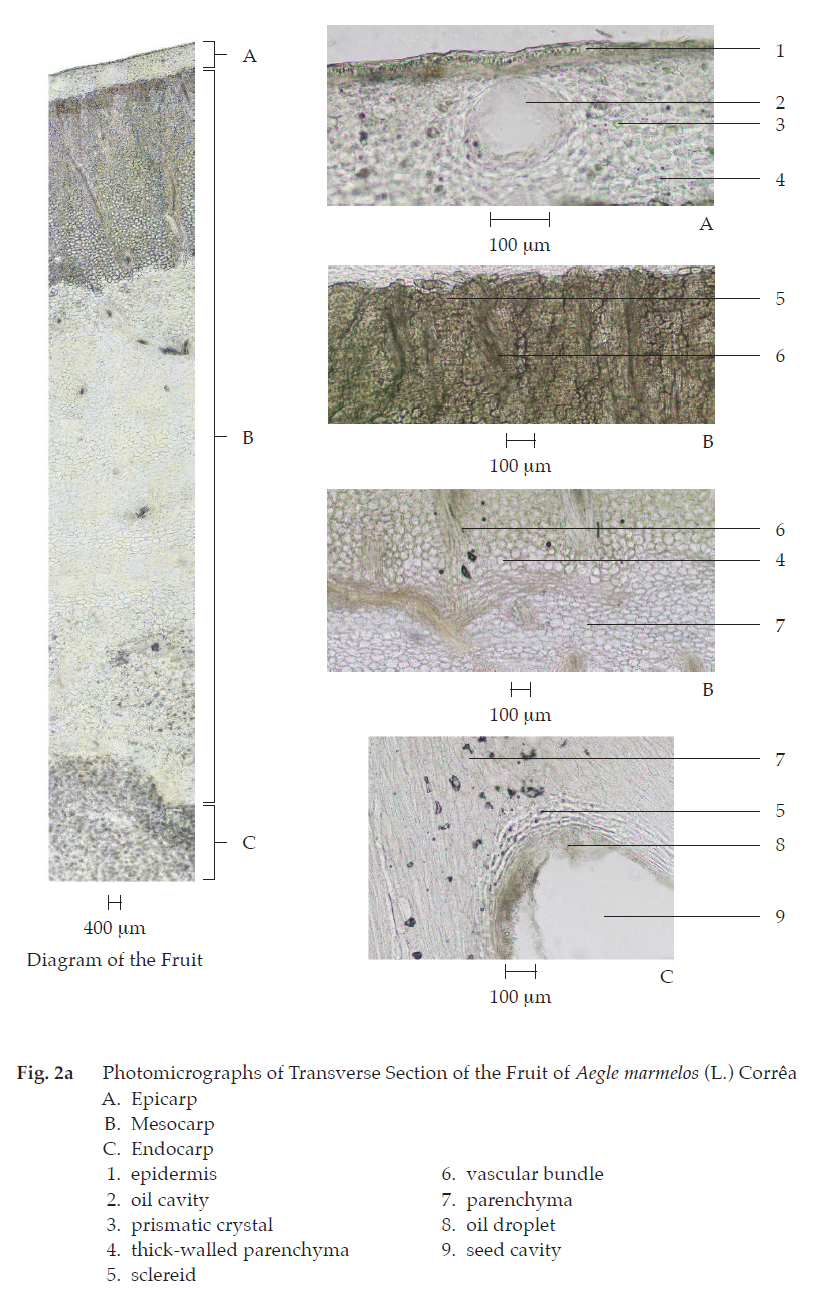
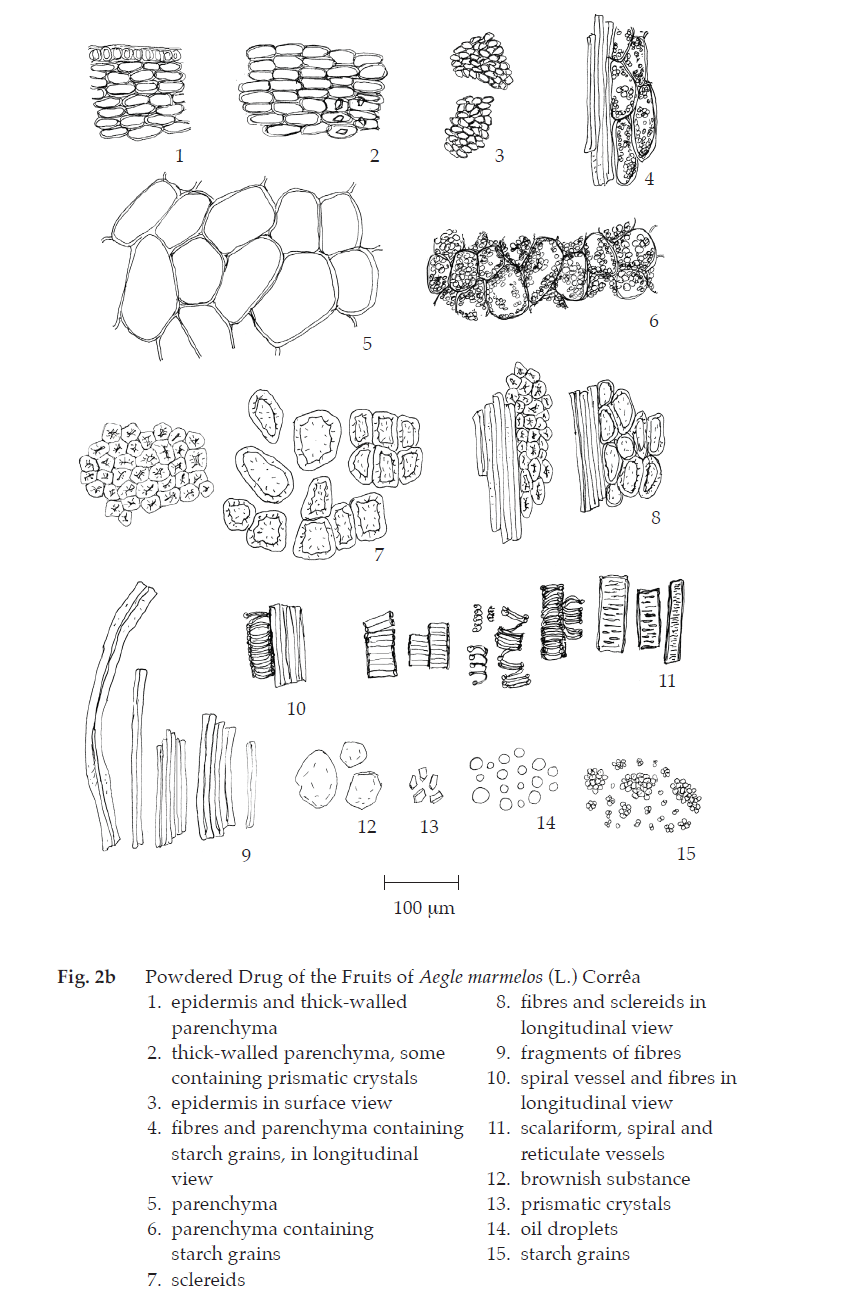
Bael Fruit in powder possesses the diagnostic microscopical characters of the unground drug. Thick-walled parenchyma, various-sized and -shaped sclereids and minute starch grains are abundant. Brownish substance, although rare, is characteristic.
Additional information In Thailand, there are three commonly known Matum cultivars: Matum Khai (มะตูมไข่), Matum Ban (มะตูมบ้าน) or Matum Kwai (มะตูมควาย), and Matum Nim (มะตูมนิ่ม). However, Matum Ban or Matum Kwai is commercially available in local markets.
Packaging and storage Bael Fruit shall be kept in well-closed containers, protected from light, and stored in a dry place.
Identification
A. Boil 500 mg of the sample, in fine powder, with 20 mL of ethanol on a water-bath for 10 minutes and filter (solution 1). Examine 2 mL of solution 1 under ultraviolet light (366 nm): a blue fluorescence is observed.
B. To 2 mL of solution 1, add a few drops of sulfuric acid and mix: a pinkish red colour is produced.
C. To 2 mL of solution 1, add a few drops of a 9 per cent w/v solution of iron(III) chloride and mix: a green colour is produced.
D. Carry out the test as described in the “Thin-Layer Chromatography” (Appendix 3.1), using silica gel GF254 as the coating substance and a mixture of 60 volumes of toluene and 40 volumes of diethyl ether as the mobile phase and allowing the solvent front to ascend 10 cm above the line of application. Apply separately to the plate, 20 μL of solution (A) and 5 μL of solution (B). Prepare solution (A) by refluxing 1 g of the sample, in fine powder, with 20 mL of n-hexane for 20 minutes, filtering and evaporating the filtrate to dryness. Dissolve the residue in 2 mL of methanol. For solution (B), dissolve 1 mg of imperatorin in 1 mL of methanol. After removal of the plate, allow it to dry in air and examine under ultraviolet light (254 nm), marking the quenching spots. The chromatogram obtained from solution (A) shows a quenching spot (hRf value 63 to 70) corresponding to the imperatorin spot from solution (B) and other two spots of lower hRf values. Subsequently examine the plate under ultraviolet light (366 nm) through the cut-off filter; several greenish blue and blue fluorescent spots are observed (Table 1); see also Fig. 3.
Table 1 hRf Values of Components in Hexane Extract of the Fruits of Aegle marmelos (L.) Corrêa
| Spot | hRf Value | Detection | |
| UV 254 | UV 366 | ||
| 1 2 3 4 5 6* 7 8 |
14-18 18-19 26-32 33-38 42-45 63-70 72-74 77-81 |
- - weak quenching weak quenching - quenching - - |
blue greenish blue greenish blue greenish blue blue greenish blue blue blue |
*imperatorin
Loss on drying Not more than 9.0 per cent w/w after drying at 105° to constant weight (Appendix 4.15).
Foreign matter Not more than 2.0 per cent w/w (Appendix 7.2).
Total ash Not more than 4.0 per cent w/w (Appendix 7.7).
Ethanol-soluble extractive Not less than 10.0 per cent w/w (Appendix 7.12).
Water-soluble extractive Not less than 40.0 per cent w/w (Appendix 7.12).
Imperatorin content Not less than 0.1 per cent w/w of imperatorin (C16H14O4). Carry out the determination as described in the “Liquid Chromatography” (Appendix 3.5).
Mobile phase Prepare a mixture of 60 volumes of methanol and 40 volumes of water. Make adjustments if necessary.
Standard preparations Dissolve an accurately weighed quantity of imperatorin in sufficient methanol, dilute quantitatively and stepwise with methanol to obtain a stock solution having a known concentration of about 400 μg per mL. Dilute the solution quantitatively and stepwise with methanol to obtain six solutions having known concentrations of 40, 80, 120, 160, 200, and 240 μg per mL.
Sample preparation Reflux about 1 g of Bael Fruit, in fine powder, accurately weighed, with 50 mL of n-hexane for 30 minutes, filter and evaporate the filtrate to dryness. Dissolve the residue in sufficient methanol. Transfer quantitatively to a 25-mL volumetric flask, dilute with methanol to volume and mix.
Chromatographic system The chromatographic procedure may be carried out using (a) a stainless steel column (5 cm × 2.1 mm) packed with octadecylsilane chemically bonded to porous silica or ceramic microparticles (1.7 μm), (b) Mobile phase at a flow rate of about 0.5 mL per minute (the retention time is about 1.2 minutes for imperatorin), and (c) an ultraviolet photometer set at 302 nm.
Procedure and Calculation Separately inject about 3 μL each of Standard preparations into the chromatograph, record the chromatograms and measure the responses for the major peaks: the relative standard deviation for the replicate injections is not more than 2.0 per cent. Plot the readings and draw the standard curve of best fit: the curve shows a correlation coefficient of not less than 0.999. Inject about 3 μL of Sample preparation into the chromatograph, record the chromatogram and measure the response for the major peak. By reference to the standard curve, calculate the content of imperatorin (C16H14O4) in the portion of the Bael Fruit taken.
Dose 3 to 6 g of the powdered drug a day.
